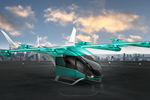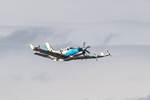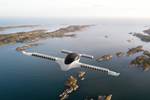Aciturri becomes investing and technology partner for Dovetail Electric
Partnership provides an opportunity to drive development of sustainable aviation via Dovetail’s upcoming hybrid electric aircraft, retrofitted with composite components.
Composites will be incorporated into Dovetail’s retrofitted aircraft. One example is this custom-built battery module that Dovetail is developing. Source (All Images) | Dovetail Electric Aviation
Aerostructures supplier and engine components manufacturer (Mirando de Ebro, Spain) has announced its commitment to acquire a stake in (New South Wales, Australia), becoming a key industrial strategic partner and lead investor in Dovetail’s seed investment round, Tranche 2.
“This partnership represents a significant opportunity to drive innovation in the aviation industry and broaden our contribution to a more sustainable future,” says Alvaro Fernandez Baragaño, CEO of Aciturri Aeroengines and chief diversification officer of the Aciturri group. “We look forward to working closely with Dovetail Electric Aviation to bring their groundbreaking technology to market.”
According to David Doral, CEO of Dovetail Electric Aviation, Aciturri’s involvement brings not only financial support but also significant capabilities that will enhance the company’s technology roadmap and accelerate its path to market.
Renders of a twin-engine Beechcraft King Air B200 that Dovetail owns and is using as a development platform for innovations such as composite air ducts.
Dovetail is initially targeting certification of its first battery-electric powered aircraft in 2026, as a first step to bring a product in the market. Later on, Dovetail will focus on the certification of electric-hydrogen aircraft conversions, with preliminary work currently underway with the integration of Dovetail’s first hydrogen-electric powertrain. The purpose behind an electric-hydrogen aircraft conversion for Dovetail is to extend the range of the battery-powered aircraft.
Doral tells CW that to achieve these goals, Dovetail is retrofitting existing aircraft. While this means the airframe stays the same, other areas will be available for composites use, including:
- Battery modules (see image above) developed in-house;
- Hydrogen tanks to be added when integrating hydrogen fuel cells;
- Specific aircraft add-ons, like cowlings or fairings required when slight modifications are performed over the original OML. A particular example are the air ducts required for extra cooling.
“There will be other opportunities we are jointly discussing, to be released in the future,” Doral says.
With this agreement Aciturri becomes the lead investor in the second tranche of Dovetail’s seed investment round. With a total target of $7 million, Dovetail split its seed round in two tranches, or parts, with the first one closed in 2023, with the airlines Rex in Australia, and Volotea and Air Nostrum in Europe, as the most relevant investors. In this second tranche, Aciturri is leading the round, to be closed shortly with the addition of at least one institutional venture capital fund
Related Content
-
“Structured air” TPS safeguards composite structures
Powered by an 85% air/15% pure polyimide aerogel, Blueshift’s novel material system protects structures during transient thermal events from -200°C to beyond 2400°C for rockets, battery boxes and more.
-
Plant tour: Airbus, Illescas, Spain
Airbus’ Illescas facility, featuring highly automated composites processes for the A350 lower wing cover and one-piece Section 19 fuselage barrels, works toward production ramp-ups and next-generation aircraft.
-
Low-cost, efficient CFRP anisogrid lattice structures
CIRA uses patented parallel winding, dry fiber, silicone tooling and resin infusion to cut labor for lightweight, heavily loaded space applications.






